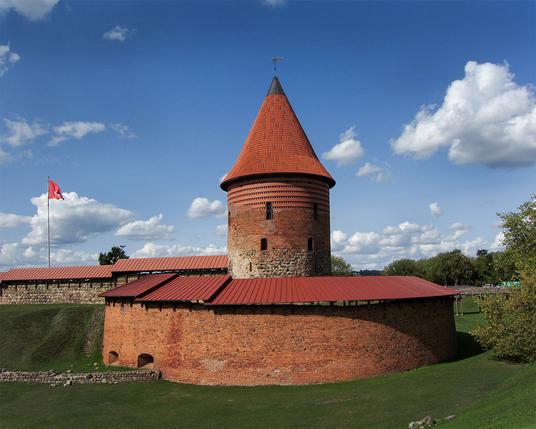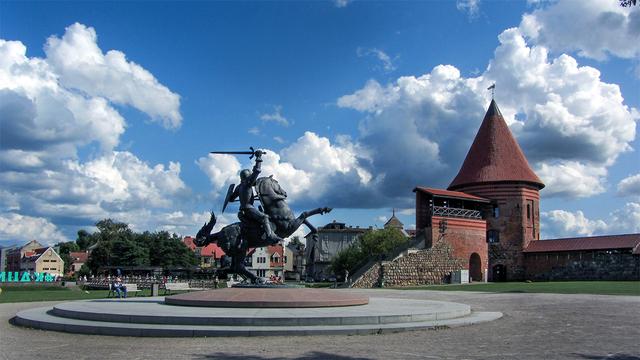#pogon
Castle in Kaunas, Lithuania (part 2 of 2)
After the Battle of Grunwald in 1410, the castle lost its strategic importance and served primarily administrative and judicial functions. In the 16th century, it was expanded, including the addition of a bastion on the southeastern side. In the 17th century, floods and warfare caused further destruction. In 1655, the town and castle burned down during the Swedish invasion, and the building ultimately fell into ruin.
Until the 18th century, the castle served as a prison, and after the Third Partition of Poland, the Russians allowed houses to be built on its grounds, further exacerbating the damage.
The castle’s location next to the flooding Neris River contributed to the collapse of sections of the walls. Only parts of the structure survive today, including a four-sided tower, wall fragments, and a bastion from the 16th century.
Archaeological and conservation work was carried out in the 20th and 21st centuries, and between 2010 and 2011, a reconstruction project was carried out, including the reconstruction of part of the tower and walls.
Currently, the castle houses a branch of the Kaunas City Museum, and the building itself is a venue for numerous cultural events, festivals and knightly tournaments, constituting one of the city’s main tourist attractions.
#kowno #kauno #kaunas #litwa #lithuania #zamek #castle #pilis #wieza #tower #baszta #pogon #vytis #miasto #city #widok #landscape #historia #history
After the Battle of Grunwald in 1410, the castle lost its strategic importance and served primarily administrative and judicial functions. In the 16th century, it was expanded, including the addition of a bastion on the southeastern side. In the 17th century, floods and warfare caused further destruction. In 1655, the town and castle burned down during the Swedish invasion, and the building ultimately fell into ruin.
Until the 18th century, the castle served as a prison, and after the Third Partition of Poland, the Russians allowed houses to be built on its grounds, further exacerbating the damage.
The castle’s location next to the flooding Neris River contributed to the collapse of sections of the walls. Only parts of the structure survive today, including a four-sided tower, wall fragments, and a bastion from the 16th century.
Archaeological and conservation work was carried out in the 20th and 21st centuries, and between 2010 and 2011, a reconstruction project was carried out, including the reconstruction of part of the tower and walls.
Currently, the castle houses a branch of the Kaunas City Museum, and the building itself is a venue for numerous cultural events, festivals and knightly tournaments, constituting one of the city’s main tourist attractions.
#kowno #kauno #kaunas #litwa #lithuania #zamek #castle #pilis #wieza #tower #baszta #pogon #vytis #miasto #city #widok #landscape #historia #history
Castle in Kaunas, Lithuania (part 1 of 2)
Kaunas Castle is considered the oldest stone castle in Lithuania, and also the only preserved one with two lines of defensive walls.
The first stone castle was built in an uninhabited area at the confluence of the Neris and Nemunas rivers, around the mid-14th century, as part of a fortification system protecting Vilnius and Trakai from the Teutonic Knights. It was an irregular quadrilateral structure with reinforced double stone walls, measuring 330 meters in length, and included two towers.
First mentioned in Teutonic sources in 1361, the castle was captured and almost completely destroyed after a three-week siege by the Teutonic Knights in 1362, who used catapults and siege towers.
After the Teutonic Knights withdrew, the Lithuanians built earthen fortifications on the spot, followed by a new stone castle. Further battles and sieges in the 14th century, including in 1384 and 1391, led to the destruction and rebuilding of the stronghold. Around 1396, the castle already belonged to the Teutonic Knights, who expanded it as a base for their campaigns.
The castle changed hands several more times as a result of armed conflicts. In 1396, an armistice was signed within its walls between the Grand Master of the Teutonic Order and Vytautas, after which Kaunas became a border town near the territory of Samogitia, which was under Teutonic rule.
#kowno #kauno #kaunas #litwa #lithuania #zamek #castle #pilis #wieza #tower #baszta #pogon #vytis #miasto #city #widok #landscape #historia #history
Kaunas Castle is considered the oldest stone castle in Lithuania, and also the only preserved one with two lines of defensive walls.
The first stone castle was built in an uninhabited area at the confluence of the Neris and Nemunas rivers, around the mid-14th century, as part of a fortification system protecting Vilnius and Trakai from the Teutonic Knights. It was an irregular quadrilateral structure with reinforced double stone walls, measuring 330 meters in length, and included two towers.
First mentioned in Teutonic sources in 1361, the castle was captured and almost completely destroyed after a three-week siege by the Teutonic Knights in 1362, who used catapults and siege towers.
After the Teutonic Knights withdrew, the Lithuanians built earthen fortifications on the spot, followed by a new stone castle. Further battles and sieges in the 14th century, including in 1384 and 1391, led to the destruction and rebuilding of the stronghold. Around 1396, the castle already belonged to the Teutonic Knights, who expanded it as a base for their campaigns.
The castle changed hands several more times as a result of armed conflicts. In 1396, an armistice was signed within its walls between the Grand Master of the Teutonic Order and Vytautas, after which Kaunas became a border town near the territory of Samogitia, which was under Teutonic rule.
#kowno #kauno #kaunas #litwa #lithuania #zamek #castle #pilis #wieza #tower #baszta #pogon #vytis #miasto #city #widok #landscape #historia #history
Done Deal! Mateusz #Legowski to #Salernitana from #Pogon for €2M. Contract until 2028. #transfers
Pogoń pogoniona koncertowo. Wstyd. #piłkanożna #pogon #sport
Orban pogrążył Pogoń.
#LKE
#piłkanożna
Trzymamy kciuki za #pogon . Powodzenia!
Dobre wieści dla polskich kibiców. Jak poinformowało TVP Sport wszystkie domowe mecze polskich drużyn w europejskich pucharach, będą pokazywane na tejże stacji. Póki co nie ma informacji, co do tego, czy któraś stacja pokaże mecze wyjazdowe.
#Raków #rakowczestochowa #Lech #LechPoznań #Legia #LegiaWarszawa #Pogoń #PogońSzczecin #LigaMistrzów #Telewizja #transmisja #LigaKonferencji #piłkanożna #futbol #football #FootballNews
Client Info
Server: https://mastodon.social
Version: 2025.07
Repository: https://github.com/cyevgeniy/lmst

